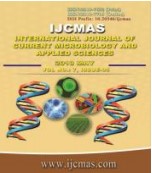


 National Academy of Agricultural Sciences (NAAS)
National Academy of Agricultural Sciences (NAAS)

|
PRINT ISSN : 2319-7692
Online ISSN : 2319-7706 Issues : 12 per year Publisher : Excellent Publishers Email : editorijcmas@gmail.com / submit@ijcmas.com Editor-in-chief: Dr.M.Prakash Index Copernicus ICV 2018: 95.39 NAAS RATING 2020: 5.38 |
Soil samples were collected from the rhizosphere of two months old grapevine grown in hi-tech and low-tech polyhouse. Forty samples each from hi-tech and low-tech polyhouse were withdrawn at four intervals i.e. May, June, July and August for two consecutive years 2016 and 2017 and processed in the laboratory for the determination of nematodes. Among the five nematode genera identified, four were plant parasitic viz., lesion nematode, Pratylenchus spp., stunt nematode, Tylenchorhynchus spp, reniform nematode, Rotylenchulus spp. and Tylenchus spp. The free living nematode identified was Rhabditis spp. Nematode population was maximum in low-tech as compared to hi-tech polyhouse nursery. The population of all the nematodes increased gradually in the soil with the passage of time i.e. from May to August. Among the plant parasitic nematodes the population of Tylenchorhynchus spp. was maximum followed by Pratylenchus spp., Tylenchus spp. and Rotylenchulus spp. both in low-tech and hi-tech polyhouse. In hi-tech polyhouse the population of Tylenchorhynchus spp. was maximum i.e. 84 and 87 in August, 2016 and 2017, respectively whereas it was minimum for Rotylenchulus spp. i.e. 28 and 35 in August, 2016 and 2017, respectively. Similar was the case in low-tech polyhouse where also the population of Tylenchorhynchus spp. was maximum i.e. 148 and 144 and population of Rotylenchulus spp. was minimum i.e. 49 and 64 in August, 2016 and 2017, respectively. Because of the high population of some plant parasitic nematodes encountered around the rhizosphere of grapevines, it is assumed that the plant parasitic nematodes form an important component of soil ecosystem and may be a contributing factor in declining health of these plants.
 |
 |
 |
 |
 |